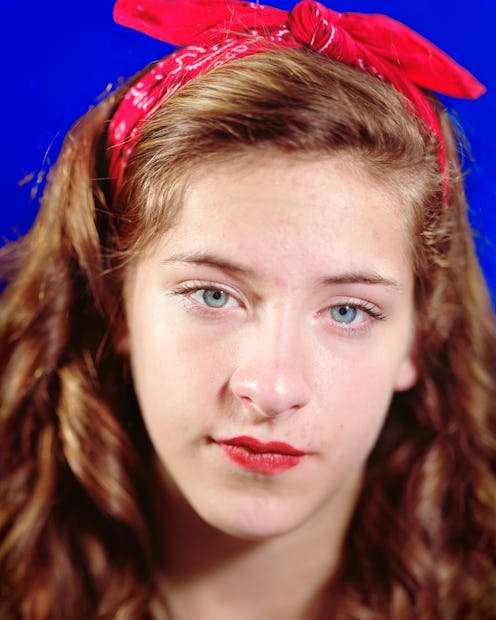
For many women and teenage girls, looking in the mirror or being photographed is emotionally difficult, perhaps because we often can't reconcile what our culture teaches us we should look like with what see. The series Spitting Image by photographer Eva O'Leary, captures honest portraits of how young women see themselves. The portraits, which are on display at Crush Curatorial through May 13 in New York City, depict teenagers who — like most women in this country — have been inundated by imagery that projects the fantasies of others onto their bodies, teaching them to suppress their desires, values, personality, and flaws, according to a statement provided to Bustle by O'Leary.
Spitting Image presents a group of photographs and videos that delve into the relationship between gender, image, commerce, and identity through found and re-performed beauty rituals. Personally, I have spent more time than I care to admit Googling things like "why don't I look in pictures the way I look in the mirror," and, even now, I try to avoid seeing my reflection in store windows and shopping mall mirrors. I'm also aware that I'm not supposed to admit this. Let's break all of the rules, shall we?
The main part of O'Leary's exhibit focuses on her portraits of adolescent girls reacting to their own images through a two-way mirror, and O'Leary's capture of them examining their reflections
What makes the images so powerful is O'Leary's ability to pair the girls’ unsettling vulnerability with the blank backdrop of a yearbook photo and the glowing light and clarity of a glamor shot. The strong emotional effect of the portraits comes from the competing themes in each image.
A stereotypical yearbook photo usually depicts a forced smile, while a glossy glamor shot is often a slickly packed illusion designed to convey a specific emotion. This, juxtaposed with the naked vulnerability of a young woman looking at her reflection when she thinks no one is watching, is a stark contrast from what most people expect to see, and it's a fiercely honest depiction of how most young women feel when looking in the mirror.
O'Leary, who holds a BFA from the California College of the Arts and an MFA from Yale, set out to create a nuanced portrait of the psychological space in which women must balance their own identities, insecurities, and desires with the ever-present reality of imagery, according to a statement provided to Bustle.
The expectations hoisted on women from every corner of society can make it hard for young girls to feel like they can measure up. I remember being 12 and taking a tall, glossy book from my mom's bookshelf that contained portraits of models from the '80s and '90s. I spent hours trying to mimic their makeup, styles, and smiles. Of course, I couldn't do it because, what no one tells young girls is that even the models themselves don't really look they way they're portrayed in magazines.
But, I didn't know this, and when I looked in the mirror I was devastated that I would never be able to achieve the level of beauty I saw staring back at me from those pages. It didn't help that my mom actually did look like those women, and I felt like even more like a failure for not measuring up.
While O'Leary's images and videos are as slick aa a glossy magazine, "the clarity of their details — the texture of face paint settling over pores, stray hairs, and furrowed brows, or a girl un-rumpling her shirt — that unmasks the bilious unreality at the heart of commercial imagery of women."
Spitting Image also contains videos that reveal the dueling anxiety and confidence of young women learning to manage the endless and intricate modulation of their own image, according to a statement provided by O'Leary.
For many young girls, being a teenager is the most difficult period of life. Your body is still growing and developing, and you can't escape the 24/7 loop of images that depict women you're told you're "supposed" to look like. The unrealistic ideals projected onto young women is an important dialogue — one that often can't be successfully had with words.